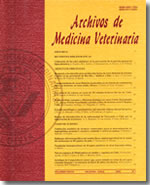Experimental infection of mice with Hysterothylacium aduncum (nematoda: anisakidae) larvae from marine-farmed trout in Chile
Main Article Content
Abstract
To evaluate the potential of Hysterothylacium aduncum as an anisakiose-disease producer in mammals and therefore in human consumers, third and fourth stage larvae of the nematode from the digestive tract of Oncorhynchus mykiss reared in netpens, were introduced surgically into the celomic cavity of six live white mice and two dead-and-refrigerated mice as controls. The experiment showed that all larval nematodes died quickly in the live warm-blooded organisms, whereas 73% of the nematodes survived 18-22 hr in the dead-and-refrigerated control mice. This anisakid nematode, having a type MA larvae, is less aggressive and morphologically different from the Hysterothylacium type MB and therefore might not produce "anisakiasis".
Article Details
How to Cite
GONZALEZ, L. (1998). Experimental infection of mice with Hysterothylacium aduncum (nematoda: anisakidae) larvae from marine-farmed trout in Chile. Archivos De Medicina Veterinaria, 30(1), 139–142. https://doi.org/10.4067/S0301-732X1998000100016
Issue
Section
COMUNICACIONES

